What Percentage of Electricity Comes From Renewable Sources

What is renewable energy?
Renewable energy is derived from natural processes that are replenished at a rate that is equal or faster than the rate at which they are consumed.
There are various forms of renewable energy, deriving directly or indirectly from the sun, or from heat generated deep within the earth. They include energy generated from solar, wind, biomass, geothermal, hydropower and ocean resources, solid biomass, biogas and liquid biofuels.
Key facts
- Renewable energy sources currently provide about 16% of Canada's total primary energy supply
- Wind and solar energy are the fastest growing sources of electricity in Canada
Learn more about renewable energy in Canada
 Main sources and uses in Canada
Main sources and uses in Canada
Renewable energy from its many sources is an incredible way to power, heat and fuel our country. Each type of renewable energy from hydro to solar to biomass contributes in a different way.
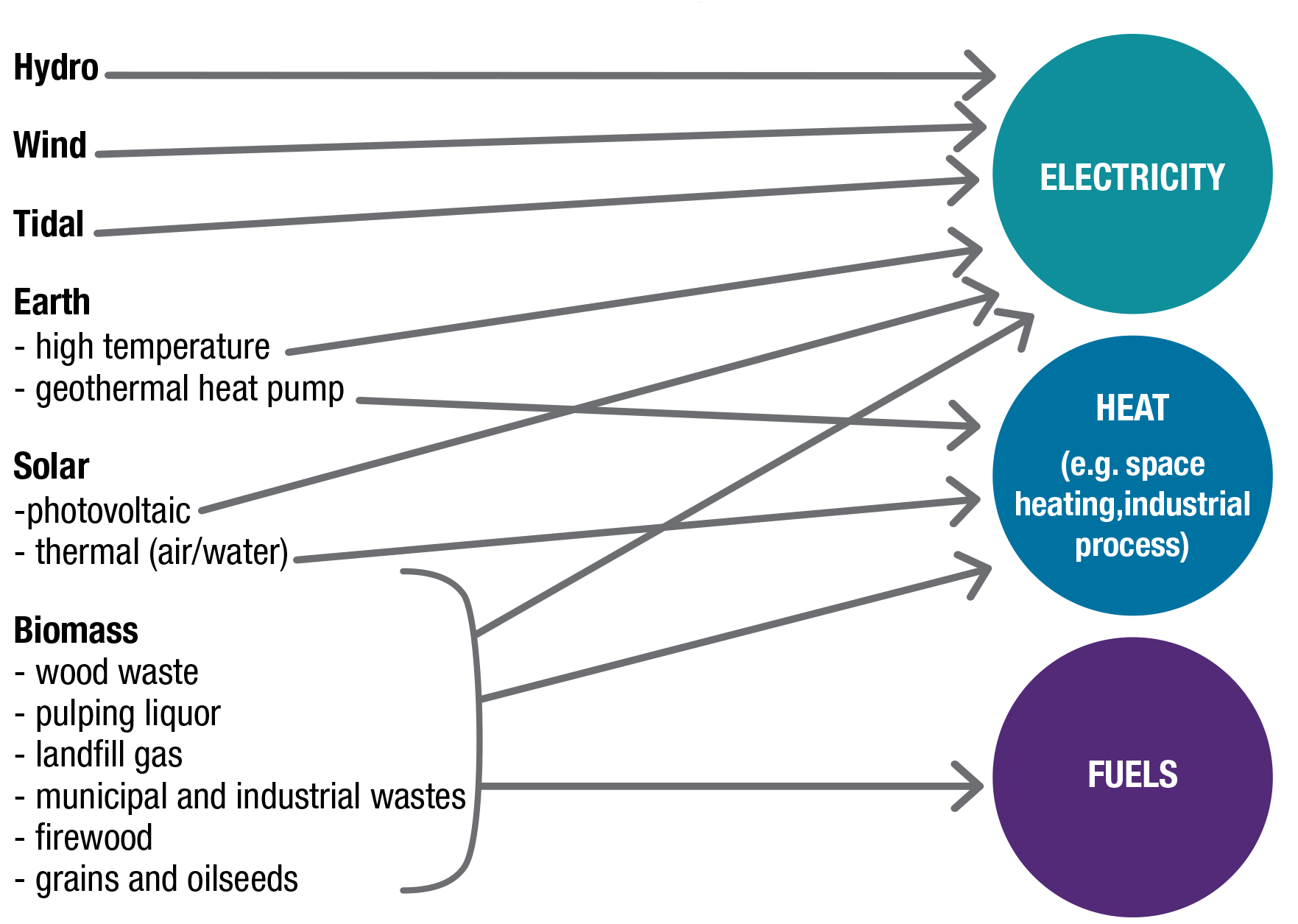
Text version
Hydro, wind, tidal, geothermal, solar, and biomass are all used to generate electricity. Geothermal, solar, and biomass can also be used for heat. In addition, biomass, such as wood waste and landfill gas, can also be transformed into fuels.
 International context
International context
Find out how Canada's renewable energy ranks on an international scale:
| Rank | Country | Percentage |
|---|---|---|
| 1 | China | 15% |
| 2 | India | 11% |
| 3 | United States | 9% |
| 4 | Brazil | 7% |
| 5 | Nigeria | 6% |
| 6 | Indonesia | 4% |
| 7 | Canada | 3% |
Compared to most OECD countries, Canada has a high share of renewables in their energy supply. 16.3% of Canada's energy comes from renewables.

Text version
In 2018, Canada obtained 16.3% of its energy supply from renewable sources. For comparison, OECD countries, on average, got 10.5% of their energy supply from renewable sources, while the world average was 13.4%.
 Canadian production
Canadian production
The primary source of renewable energy in Canada comes from moving water. Wind power capacity has been growing steadily in the last 10 years.
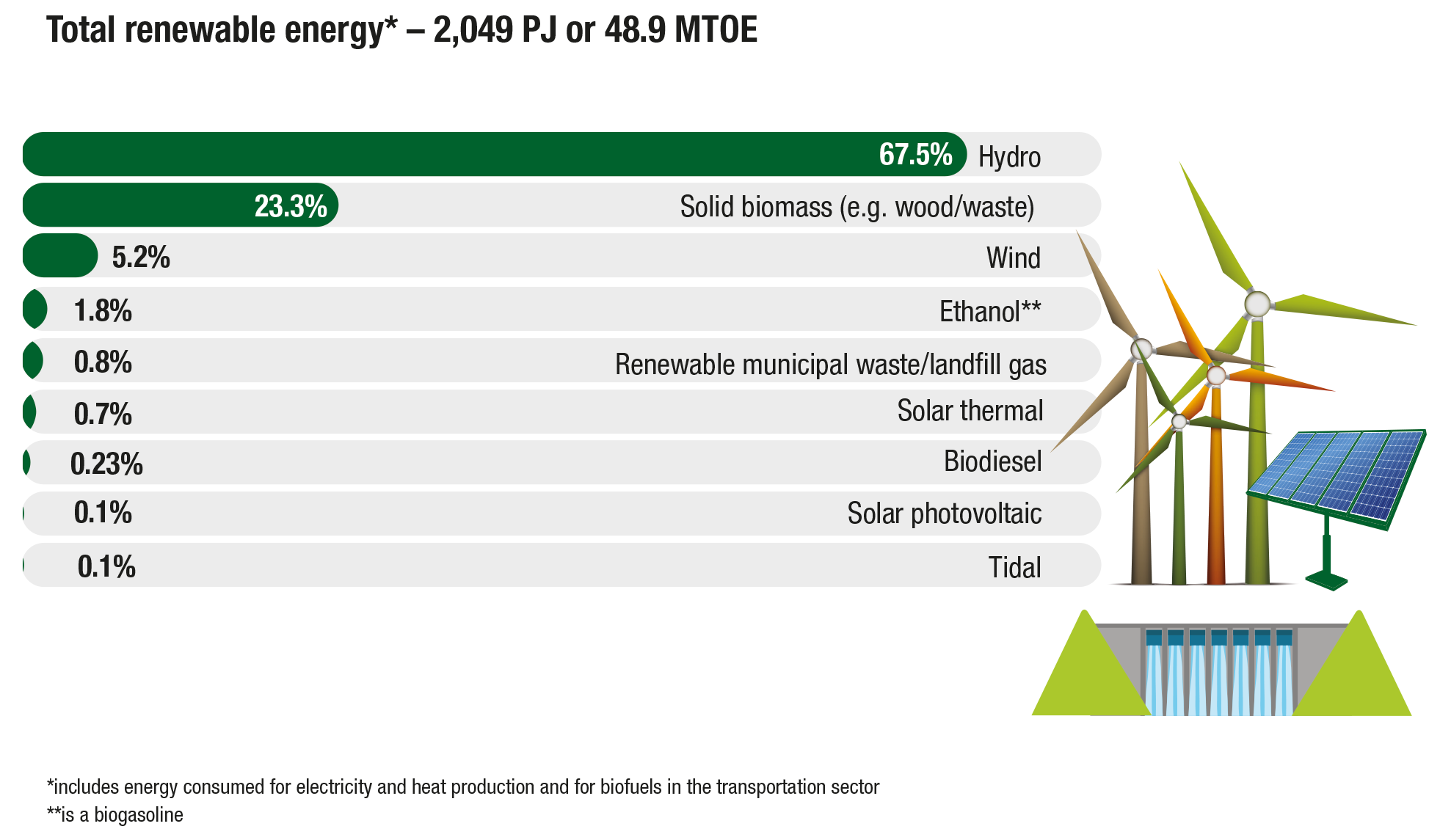
Text version
In 2018, hydro accounted for 67.5% of Canada's total renewable energy use, followed by solid biomass at 23.3%, wind at 5.2%, ethanol at 1.8%, renewable municipal waste and landfill gas at 0.8%, solar at 0.1%.

Text version
The amount of hydro capacity has been increasing slowly since 2006, reaching 81,836 megawatts in 2018. Wind and solar capacity has been growing as well since 2006, reaching 12,817, and 3,100 megawatts respectively in 2018.
 Hydroelectricity
Hydroelectricity
Moving water is the most important renewable energy source in Canada, providing 60% of Canada's electricity generation. In fact, in 2018, Canada was the third largest producer of hydroelectricity in the world.
International context
Find out how Canada's hydroelectricity ranks on an international scale:
World Generation of Hydroelectricity
| Rank | Country | Percentage of Total |
|---|---|---|
| 1 | China | 28% |
| 2 | Brazil | 9% |
| 3 | Canada | 9% |
| 4 | United States | 7% |
| 5 | Russia | 5% |
Share of hydroelectricity
| Rank | Country | Percentage |
|---|---|---|
| 1 | Norway | 95% |
| 2 | Brazil | 65% |
| 3 | Canada | 60% |
| 4 | Sweden | 38% |
| By comparison | ||
| - | China | 17% |
| - | United States | 7% |
Hydroelectricity capacity in Canada
Hydroelectricity is generated across the country. In 2018, Canada's hydroelectricity capacity was 81,386 megawatts (MW).

Text version
There are 518 hydro facilities in Canada with a capacity of at least 1 megawatt, and 45 facilities less than 1MW for a total of 563 facilities. There are 20 of which are over 1,000 megawatts of capacity. Total hydro capacity in Canada was 81,386 megawatts in 2018. The largest hydro facility is the Robert-Bourassa plant with 5,616 megawatts of capacity.
 Biomass
Biomass
Biomass is a renewable energy resource derived from living organisms and/or their byproducts. Biomass accounts for the largest share of renewable energy production in the OECD, at 35%. In Canada, that share is 23% – the second largest after hydro's 68%.
In 2018 there were 36 operational co-generation units at pulp and paper mills and 41 Independent Power Providers (IPP) using biomass. Electrical capacity of pulp and paper co-generation was 3,427 MW, while heat capacity was 1,348 MW. IPP capacity for electricity and heat was 794 MW and 400 MW, respectively. In 2017, there were also 351 bioheat projects, of which 82% are less than 1MW. Institutions, including schools and hospitals, are the strongest market for bioheat in Canada.
Canadian production
Wood derived material is the most commonly used biomass.

Text version
Canada's total production of biomass energy has been between 504 and 610 petajoules since 2000. The production of wood pellets has been increasing slowly throughout that time. Solid and liquid wood waste make up between 65% and 76% of total biomass energy.
Industrial and residential sectors primarily use wood fuel for heat.

Text version
In 2016, wood fuel use was 432.2 petajoules. 45% of wood fuel is used by industry, 29.1% by residences and 25.6% is used for electricity generation.
Learn more about biomass.
 Wind
Wind
Electricity from wind energy is one of the fastest growing sources of electricity in the world and in Canada. Wind accounts for 5.1% of electricity generation in Canada in 2018.
International Context
Find out how Canada's wind power ranks on an international scale:
| Rank | Country | Percentage of Total |
|---|---|---|
| 1 | China | 36% |
| 2 | United States | 16% |
| 3 | Germany | 9% |
| 4 | India | 6% |
| 5 | United Kingdom | 4% |
| 6 | France | 3% |
| 7 | Brazil | 2% |
| 8 | Canada | 2% |
Wind Power in Canada
In 2018, Canadian generation of wind power was 32.9 terrawatt-hour (TWh). The total capacity of the Canadian industry was 13,417 MW as of December 2019.
.png)
Text version
The installed capacity of wind power has grown from 444 megawatts in 2004 to 13,417 megawatts in 2019. The amount of annual new capacity peaked in 2014 with 1,891 megawatts. In 2019, 600 megawatts were added.
Capacity by province
Canada's geography makes it ideally suited to capitalize on large amounts of wind energy, therefore wind energy is produced across Canada. In 2019, Ontario had the most wind energy capacity with 5,436 MW of power, followed by Quebec with 3,882 MW of power.

Text version
Ontario has the most installed wind capacity with 5,436 megawatts or 41% of Canada's total, followed by Quebec at 3,882 megawatts or 29%, Alberta at 13%, British Columbia at 5% and Nova Scotia at 5%.
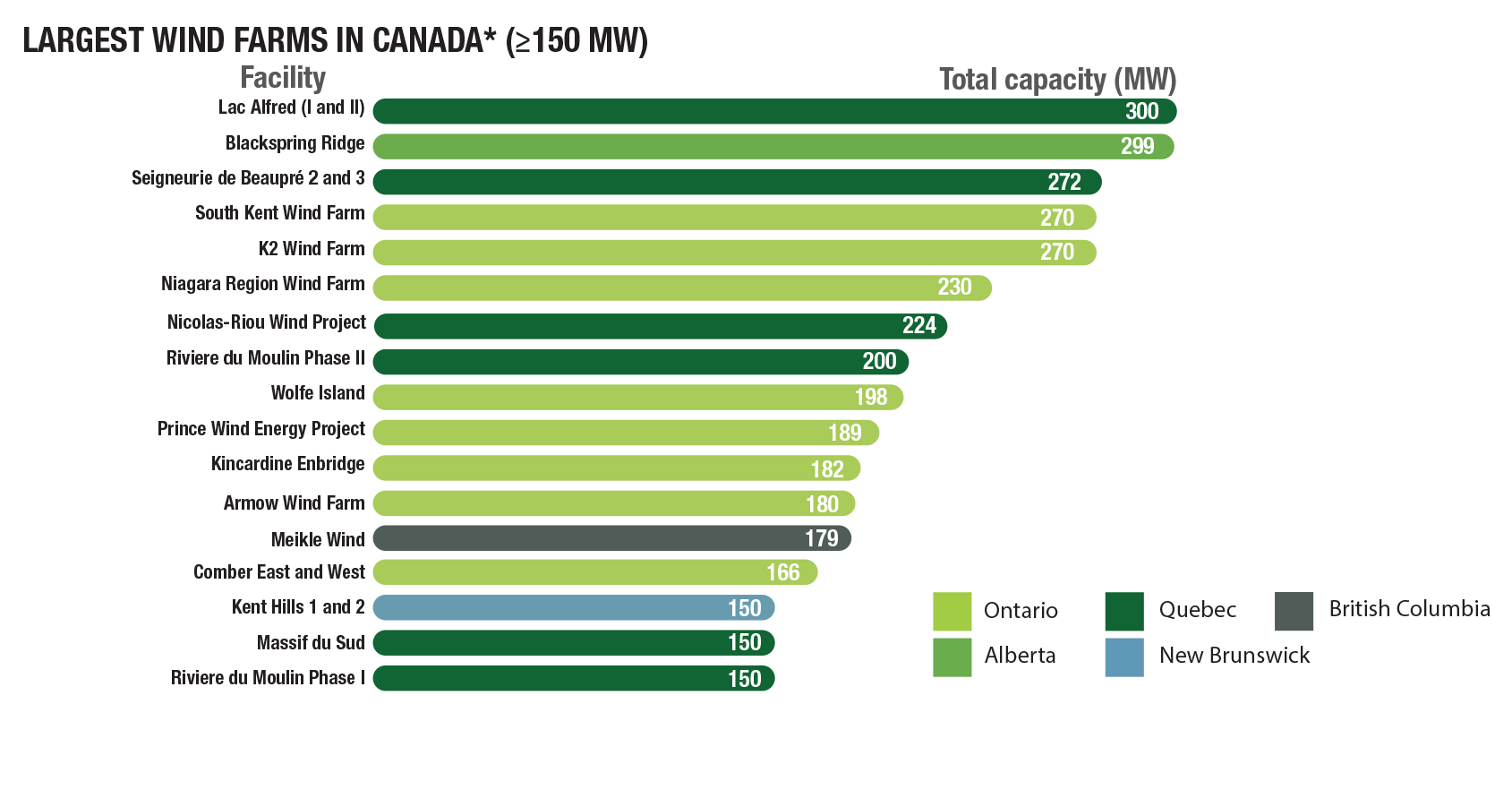
Text version
In 2019, there were 265 wind farms in Canada with at least 1 megawatt of capacity. There are 18 wind farms with at least 150 megawatts. The largest wind farm is Lac Alfred with 300 megawatts.
 Solar photovoltaic
Solar photovoltaic
Solar power is the conversion of energy from sunlight into electricity. Solar photovoltaics (PV) are rapidly becoming an economical, renewable technology to harness renewable energy from the sun.
International context
Find out how Canada's solar photovoltaic ranks on an international scale:
| Rank | Country | Percentage of Total |
|---|---|---|
| 1 | China | 33% |
| 2 | United States | 12% |
| 3 | Japan | 10% |
| 4 | Germany | 8% |
| 5 | India | 7% |
| 9 | Canada | 1% |
Solar PV in Canada
Most of the solar capacity in Canada is located in Ontario. In 2018, the capacity of the solar photovoltaic industry in Canada was 3,040 MW.
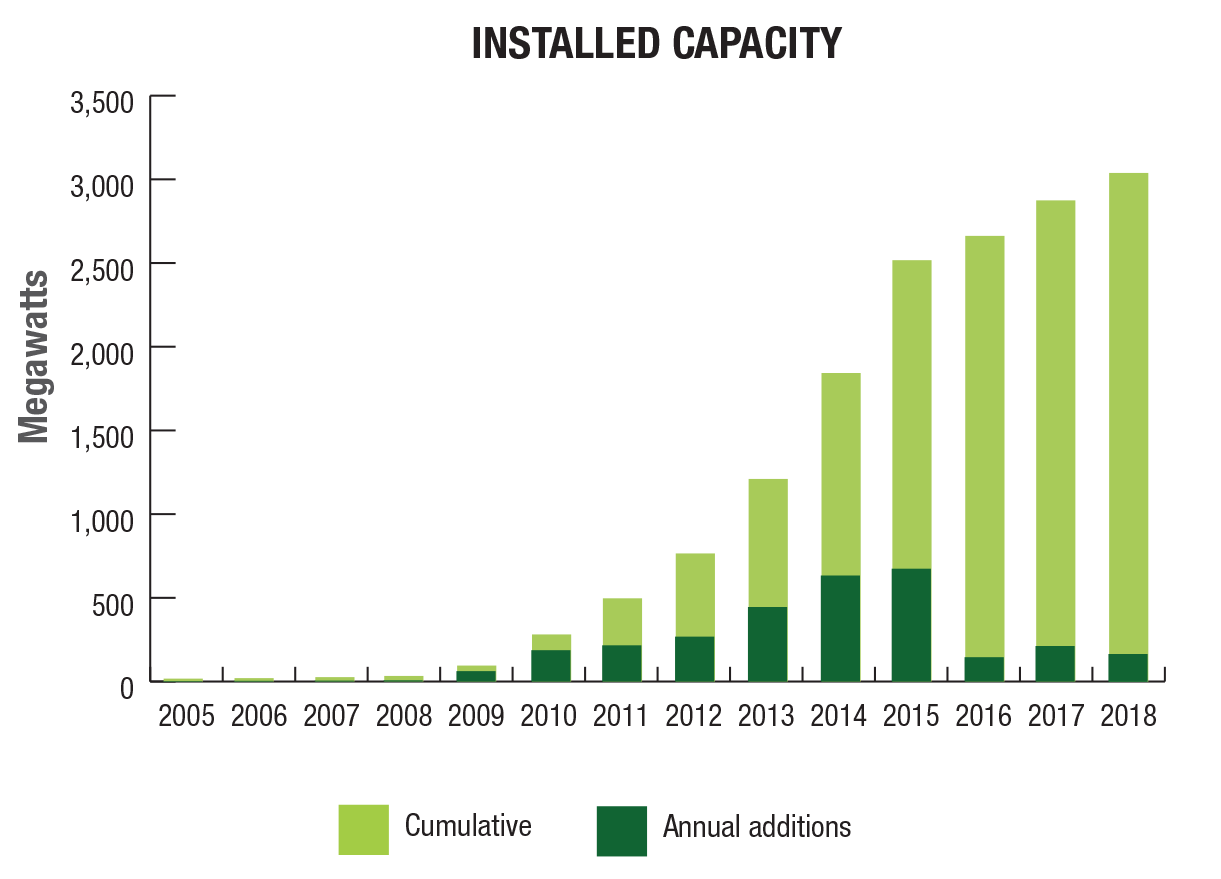
Text version
The installed capacity of solar power has grown from 16.7 megawatts in 2005 to 3,040 megawatts in 2018. In 2018, 166 megawatts were added.
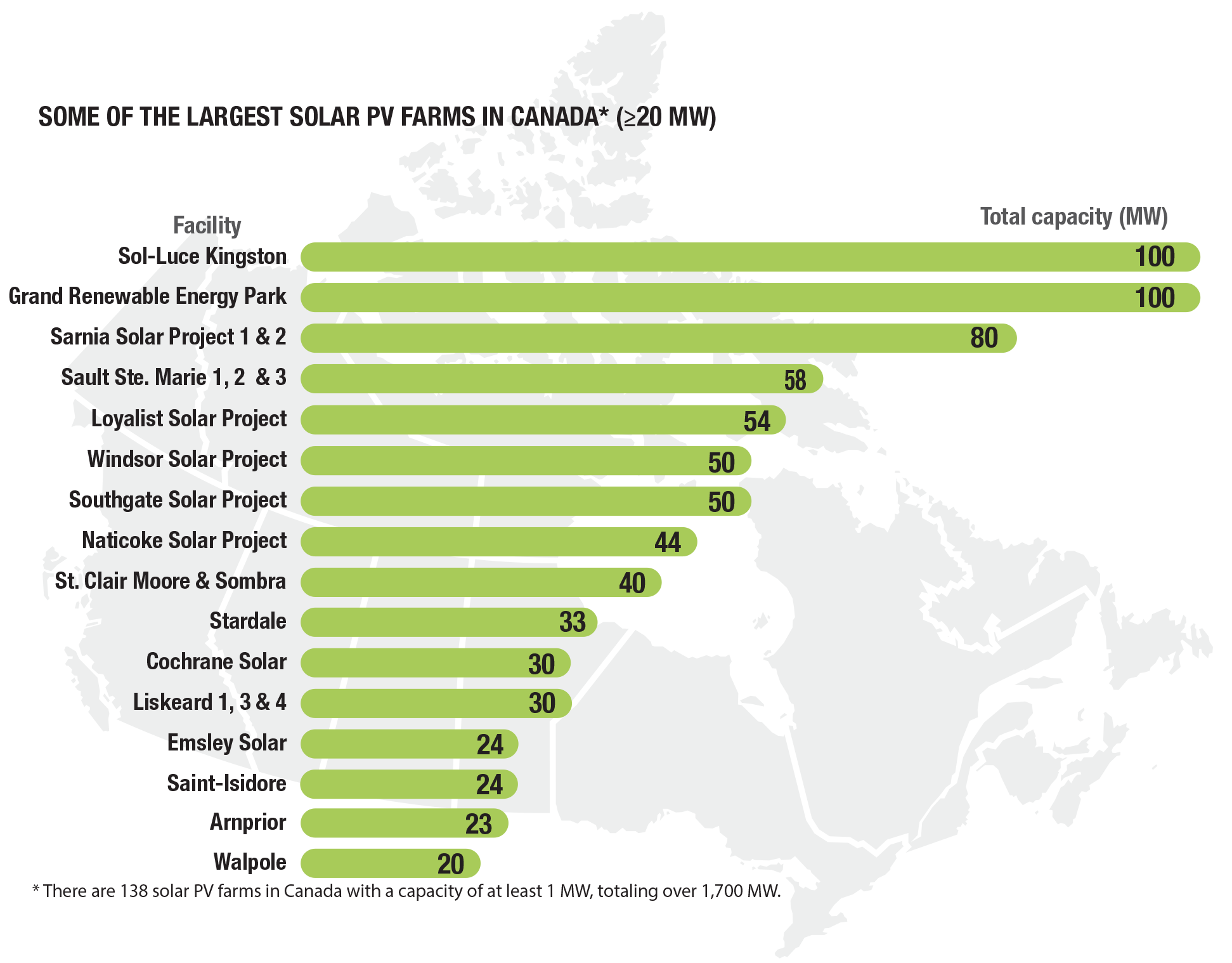
Text version
The largest solar farms in Canada are Sol-Luce Kingston and the Renewable Energy Park, both with 100 MW of capacity.
 Liquids biofuels
Liquids biofuels
Liquid biofuels are enhanced biomass-derived fuels that can take the form of a liquid such as ethanol or renewable diesel fuels. The liquid biofuels are mixed with traditional gasoline and diesel to reduce the overall greenhouse gas emissions associated with the blended fuel.
International context
Find out how Canada's biofuels rank on an international scale:
| Rank | Country | Percentage |
|---|---|---|
| 1 | United States | 41% |
| 2 | Brazil | 26% |
| 3 | European Union | 12% |
| 4 | Indonesia | 5% |
| 5 | China | 3% |
| 8 | Canada | 1% |

Text version
The annual global production of biofuels grew rapidly from 6.7 billion litres in 2000 to 161 billion litres in 2019. The United States is the largest producer, followed by Brazil. Together both countries produced 67% of biofuels in 2019.
Canadian supply and demand
In 2018, Canadian production of biofuels reached 33.0 Mb/d (1,900 million L) of ethanol and 6.9 Mb/d (400 million L) of biodiesel. Other biofuel activity included:
| Activity | Ethanol | Biodiesel |
|---|---|---|
| Mb/d (million L) | ||
| Canadian production | 33.0 (1,900) | 6.9 (400) |
| Imports | 21.2 (1,232) | 9.4 (548) |
| Exports | 0 | 5.2 (301) |
| Domestic use | 54.2 (3,132) | 11.2 (647) |
Regulations
The federal Renewable Fuels Regulations require fuel producers and importers to have an average renewable content of at least 5% based on the volume of gasoline that they produce or import, and at least 2% of the volume of diesel fuel that they produce and import*
* Heating distillate oil volumes for space heating purposes are excluded from the diesel regulations.
Sources
- International context – share of energy supply: International Energy Agency (Electricity Information, Energy Balances of OECD Countries, and Energy Balances of Non-OECD Countries), United States Energy Information Administration
- Domestic production: International Energy Agency (Renewables Information), NRCan data based on Statistics Canada
- Hydro – international generation: United States Energy Information Administration United States Energy Information Administration
- Hydro – capacity in Canada: Statistics Canada table 25-10-0022-01 and compiled by NRCan
- Hydro – facilities and projects: compiled by NRCan from Statistics Canada and other public sources
- Wood and wood waste – production: Statistics Canada table 25-10-0031-01, Statistics Canada International Merchandise Trade Database and NRCan
- Wood and wood waste – trade: Statistics Canada International Merchandise Trade Database
- Wind – capacity in Canada: compiled by NRCan from multiple sources (e.g. Canadian Wind Energy Association, Statistics Canada, NRCan)
- Wind – generation in Canada: Statistics Canada table 25-10-0020-01
- Wind – wind farms: compiled by NRCan from Statistics Canada data and other public sources (including Canadian Wind Energy Association)
- Solar PV – solar PV farms: compiled by NRCan from Statistics Canada data and various public sources
- Solar PV –generation in Canada: Statistics Canada table 25-10-0020-01
- Biofuels – Canadian production/capacity of biofuels and World production/capacity of biofuels: Bloomberg New Energy Finance, F.O. Licht, Food and Agricultural Policy Research Institute, NRCan, United States Energy Information Administration, Environment and Climate Change Canada
- Biofuels – supply and demand and production: Bloomberg New Energy Finance, F.O. Licht, Food and Agricultural Policy Research Institute, Environment and Climate Change Canada (2016 Biodiesel Production from Industry Representatives)
- Biofuels – imports/exports: Statistics Canada data and Statistics Canada International Merchandise Trade Database
What Percentage of Electricity Comes From Renewable Sources
Source: https://www.nrcan.gc.ca/science-and-data/data-and-analysis/energy-data-and-analysis/energy-facts/renewable-energy-facts/20069
0 Response to "What Percentage of Electricity Comes From Renewable Sources"
Post a Comment